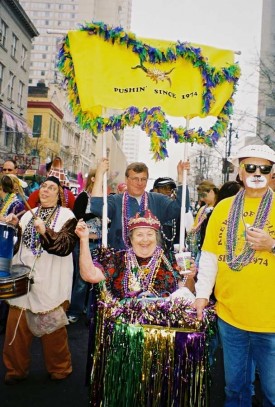Rex and his queen officially reign over Carnival, but who are the real movers and shakers of the realm? Carnivaldom is full of iconoclastic provocateurs, gifted artisans and visionary revelers who collectively enrich the panorama of the festivities.
Reveling in eccentricity
In an unpublished interview with the late New Orleans journalist Don Lee Keith in the 1970s, Tennessee Williams observed that “in New York, eccentrics, authentic ones, are ignored. In Los Angeles, they’re arrested. Only in New Orleans are they permitted to develop their eccentricities into art.”
Not surprisingly, in one of the last bastions of bohemian culture — where eccentricity is a civic virtue, and where making a spectacle of oneself is elevated to an art form — Mardi Gras brings out some of the most colorful of characters. While Rex and his queen officially reign, Carnivaldom is full of gifted artisans, larger-than-life personalities and visionary revelers who collectively enrich the panorama of the festivities. Many are regular professional types one wouldn’t typically associate with indulging in primal fantasies and extreme forms of escapism.
Queen Coleen on Mardi Gras 2003
An accomplished professional — and consummate New Orleans eccentric who became a Mardi Gras icon. —Photo ©Pat Jolly
Consider the late Coleen Salley, one of the first Colorful Characters profiled in these pages. She taught children’s literature and promoted writers and illustrators of children’s books for decades, then parlayed her gift as a storyteller into a second career a professional raconteur and acclaimed author of her own storybooks.
Some of her students, alas, were surprised to encounter her on Mardi Gras riding around in a grocery cart known as the Royal Chariot — blowing kisses and parting crowds as people bowed and curtsied, showered her with beads, plied her with libations and rejoiced in cheers of “Hail to the queen, the queen Co-leen!” She was, indeed, the living embodiment of New Orleans’s rollicking spirit and love of revelry.
F’sure: The creative, laissez-faire atmosphere of the city, and of Mardi Gras in particular, affords many opportunities to dress up and indulge alter egos. But most of the Colorful Characters you’ll find here are, in some sense, representative of a longstanding tradition in Western culture — beginning with the Greek myth of Dionysus, extending through the reign of the king of Roman Saturnalia and, in medieval times, revived in the persona of the Lord of Misrule. In the great houses of Europe, as noted by New Orleans journalist James Gill in his book Lords of Misrule: Mardi Gras and the Politics of Race in New Orleans, this archetypical colorful character coordinated festivities associated with feast of the Epiphany (January 6) — also known as Kings’ Day or Twelfth Night (it’s the twelfth day of Christmas, the day the gift-bearing Magi visited the Christ child). As it evolved into a major celebration alongside Carnival, the holiday became a glittering finale to a 12-day Christmas cycle, with elaborate entertainments featuring conjurers, acrobats, jugglers, harlequins and other humorous characters. As orchestrator and emcee, the Lord of Misrule was kin to Carnival’s King of the Fools (most famously represented by the character Quasimodo in Victor Hugo’s novel The Hunchback of Notre Dame).
In the New World, a Mobile, Ala. cotton broker picked up the touch and stoked what became the Mardi Gras tradition as we know it today, as represented by the “krewe” system. On a rainy Christmas Eve night in 1831, Michael Krafft — described in a contemporary account as “a fellow of infinite jest and…fond of fun of any kind” — apparently found himself in the doorway of a hardware store, quite likely intoxicated. He gathered up a string of cowbells and attaching them to the teeth of a rake, went on his merry way, clattering. According to an account of the night’s events cited by Carnival historian Samuel Kinser, in his book Carnival, American Style, Krafft, having drawn a crowd, caught the attention of a passer-by who exclaimed, “ ‘Hello, Mike — what society is this?’ Michael, giving his rake and extra shake and looking up at his bells, responded, ‘This? This is the Cowbellion de Rakin Society.’ ”
That may be folklore. But in any case, on subsequent rambles, Krafft was joined by other “Cowbellions,” and the group went on to become Mobile’s premiere Carnival organization, sponsoring New Year’s Eve masquerades and even venturing to New Orleans in the late 1830s to partake in Mardi Gras. In 1840, the krewe presented its first parade with floats depicting a specific theme: “Heathen Gods and Goddesses.” A masked ball followed.
Some of the founders of the prototypical New Orleans Mardi Gras krewe, Comus, had ties to Mobile and the Cowbellion de Rakin Society. The Comus krewemen, moreover, are said to have borrowed costumes from the Cowbellions for their inaugural Mardi Gras pageant, in 1857.
If the Mardi Gras spirit is defined as an enduring human capacity for merriment and make-believe, for mirthful foolery and the creative indulgence of whimsy, then Michael Krafft stands as its mythic personification. The archetypal reveler-ringleader, a New World Lord of Misrule, whose waggish flamboyance was at the very core of the cultural enterprise that became Gulf Coast Mardi Gras.
Here’s to more Colorful Characters following in his footsteps for many years to come. All hail!
MardiGrasTraditions.com

